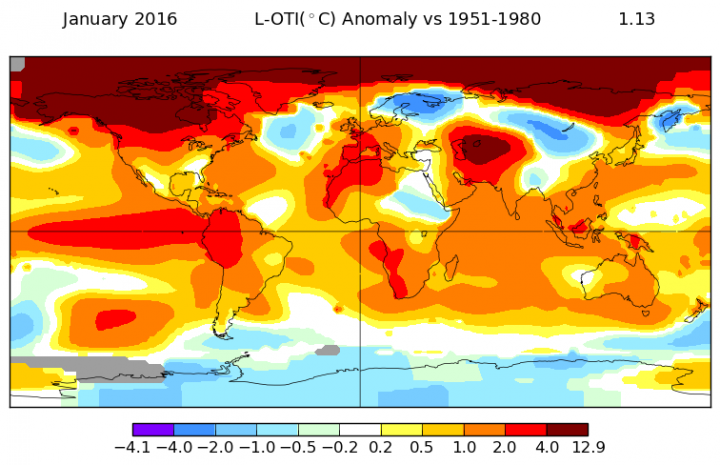January Smashed Another Global Temperature Record

This January was the warmest January on record by a large margin while also claiming the title of most anomalously warm month in 135 years of record keeping. The month was 1.13°C — or just a smidge more than 2°F — above normal. That tops December's record of being 1.11°C — or just a smidge below 2°F — above average.
It marks the fourth month in a row where the globe has been more than 1°C (1.8°F) above normal. Incidentally, those are the only four months where the globe has topped that mark since record keeping began.
Global Warming Key Driver of 2015’s Record Heat El Niño Heat Peaks, But Impacts Still to Come 2015 Shatters Hottest Year Mark; 2016 Hot on its Heels?
Large swaths of the globe were painted red by warmth to the point where it's easier to talk about where the heat wasn't (that would be Antarctica, Scandinavia, East Africa and a few parts of Russia for the record). The telltale signal of El Niño's heat in the Pacific continues to be notable, but it's the Arctic that truly stands out as the most abnormally warm place on the planet.
According to NASA, temperatures in some parts of the Arctic averaged up to 23°F above normal for the month. No, that's not missing a decimal point.
The extreme warmth in the region sent sea ice dwindling to a new record low for January. Sea ice extent was 402,000 square miles below average, according to the National Snow and Ice Data Center. That’s the equivalent of a missing area of sea ice almost four times the size of Colorado, and puts this year right in line with a trend of ever decreasing sea ice in the region as the climate warms.
Since 1979, winter sea ice extent has decreased 3.2 percent per decade (the loss is much more pronounced in summer at a rate of 13.4 percent per decade).
Get the world’s most fascinating discoveries delivered straight to your inbox.
The first half of February has continued the trend of pronounced heat in the Arctic with no signs of it letting up soon. The western U.S., which was also a hot spot in January, is continuing to see abnormal warmth this February as is the East Coast after a brief cold blast this weekend.
Global heat is somewhat a symptom of El Niño. The climate phenomenon of warm water in the eastern tropical Pacific might have passed its peak, but is still providing a little boost to global temperatures.
The big driver, though, is human-caused climate change, according to a Climate Central analysis.
With January off to record heat, it reinforces the likelihood that 2016 could be yet another record-setting year. The U.K. Met Office has already released its forecast for 2016. It expects the globe to "be at least as warm, if not warmer" than 2015, according to Chris Folland, a Met Office research fellow.
If 2016 sets another global temperature record, that would make it back-to-back-to-back years of record setting hot temperatures. That's never happened before.
And regardless of whether 2016 sets a record or not, some scientists think the world has stepped up to a new period of global warming. That doesn't mean every year will set a record, but "it seems to me quite likely that we have taken the next step up to a new level," National Center for Atmospheric Research climate scientist Kevin Trenberth told Climate Central last month.
Originally published on Climate Central.




